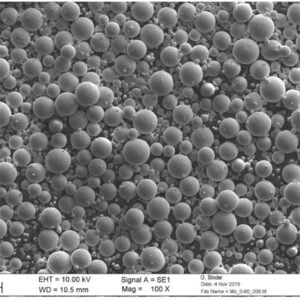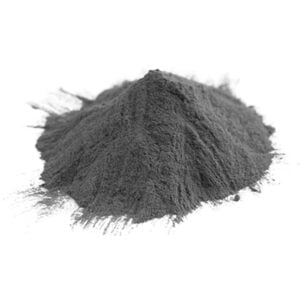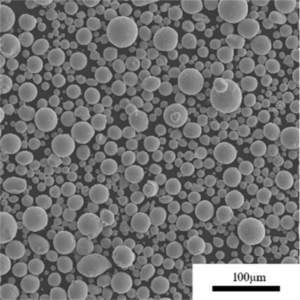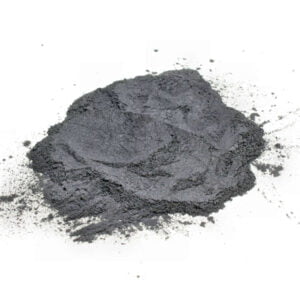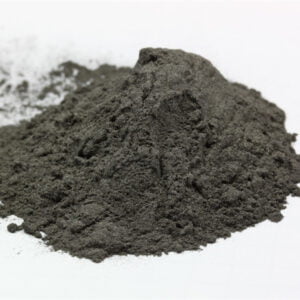티타늄 몰리브덴 합금 분말
목차
티타늄 몰리브덴 합금 분말 경량 항공우주 설계를 위한 고온 강도와 크리프 저항성을 향상시킵니다. 이 가이드에서는 TiMo 합금 분말의 구성, 주요 특성, 생산 방법, 적합한 응용 분야, 사양, 구매 고려 사항, 공급업체 비교 및 장단점을 검토합니다.
티타늄 몰리브덴 합금 분말 일반적인 구성
| 합금 등급 | 티타늄(%) | 몰리브덴(%) |
|---|---|---|
| Ti-6Al-7Nb(IMI 550) | 잔액 | 7% |
| Ti-15Mo-3Nb-3Al-0.2Si | 잔액 | 15% |
| Ti-11.5Mo-6Zr-4.5Sn(Ti-11) | 잔액 | 11.5% |
| Ti-15Mo-5Zr-3Al | 잔액 | 15% |
몰리브덴은 7%에서 15% 사이로 고온 강화에 효과적입니다. 니오븀, 지르코늄, 주석과 같은 다른 원소들은 크리프 특성을 더욱 향상시킵니다.
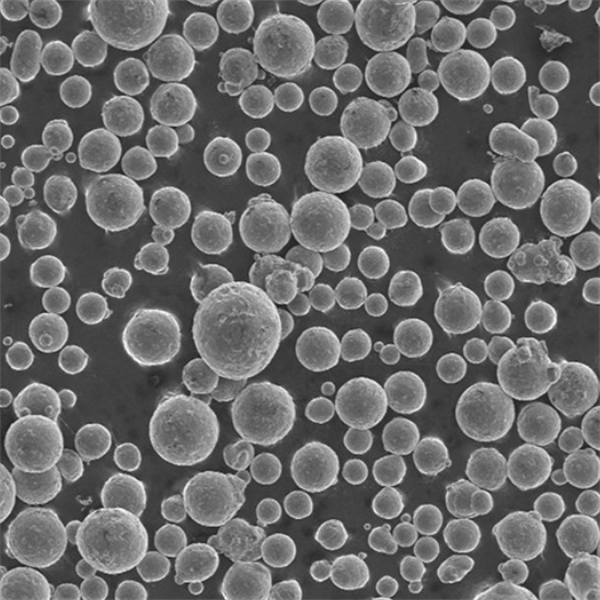
특성 및 속성
| 속성 | 세부 정보 |
|---|---|
| 파티클 모양 | 불활성 가스 분무로 구형화 |
| 산소 ppm | 500ppm 미만 |
| 일반적인 밀도 | 4.5g/cc |
| 열 전도성 | 4-6 W/mK |
| 고온 강도 | 500°C에서 100MPa |
| 내식성 | 보호용 TiO2 필름 형성 |
미립자 특성, 낮은 산소 함량 및 맞춤형 조성은 적층 제조 또는 고성능 부품 소결에 적합한 합금 분말에 적합합니다.
생산 방법
| 방법 | 프로세스 설명 |
|---|---|
| 가스 분무 | 불활성 가스가 용융 합금 스트림을 분말로 분해합니다. |
| 플라즈마 분무 | 매우 깨끗하지만 가스 분무 대비 낮은 분말 출력 |
| 예습 | 재용융을 통한 기존 분말의 구상화 |
| 수화물-수소화물 | 분쇄용 부서지기 쉬운 TiH2 중간체 |
플라즈마 및 가스 분무는 최고의 품질을 제공하지만 PREP 및 HDH와 같은 보조 경로에 비해 비용이 더 많이 듭니다.
TiMo 합금 분말의 응용 분야
| 산업 | 컴포넌트 예제 |
|---|---|
| 항공우주 | 터빈 블레이드, 케이싱, 랜딩 기어 |
| 전력 생산 | 열교환기, 증기 배관 |
| 화학 처리 | 바이오리액터, 반응 용기 |
| 해양 | 프로펠러 샤프트, 소나 돔 |
| 석유 및 가스 시추 | 지열 우물 도구 및 샤프트 |
고강도, 경량 및 내식성의 조합은 항공기 엔진이나 해양 시추와 같은 까다로운 환경에 적합한 TiMo 합금에 적합합니다.
사양
| 표준 | 적용되는 성적 |
|---|---|
| ASTM B862 | Ti-6Al-2Sn-4Zr-6Mo, Ti-8Al-1Mo-1V, Ti-6Al-2Nb-1Ta-0.8Mo |
| ASTM B348 | 티타늄 및 티타늄 합금 바 및 빌릿 |
| AIMS 04-18 | AM 티타늄 부품의 표준 |
AMPM(미국 분말 야금학) 연구소, IPS(국제 분말 야금 표준 기구)에서도 다양한 Ti 등급을 다루고 있습니다.
글로벌 공급업체 및 가격 범위
| 회사 | 리드 타임 | 가격 책정 |
|---|---|---|
| TLS 테크닉 | 16주 | $300 - $900/kg |
| 샌드빅 | 12주 | $350 - $1000/kg |
| 대서양 장비 | 14주 | $320 - $850/kg |
100kg 이상 배치에 대한 가격. 저산소 및 구형 분말용 프리미엄. 500kg 이상 대량 구매 시 20%+ 할인을 제공합니다.
장점과 단점
| 장점 | 도전 과제 |
|---|---|
| 뛰어난 고온 강도 | 높은 원자재 비용 |
| 다양한 환경에서의 내식성 | 맞춤형 합금을 위한 더 긴 리드 타임 |
| 맞춤형 합금 설계 유연성 | 현재 제한된 글로벌 공급망 |
| 파우더 AM 방식과 호환 가능 | AM 이후 후처리가 필요한 경우가 많습니다. |
| 우수한 크리프 저항성 | 산소/질소에 대한 엄격한 요구 사항 |
TiMo 파우더는 새로운 부품 설계와 경량 구조를 가능하게 하지만 티타늄 합금을 사용하면 고유한 파우더 제조 및 취급 문제가 발생합니다.
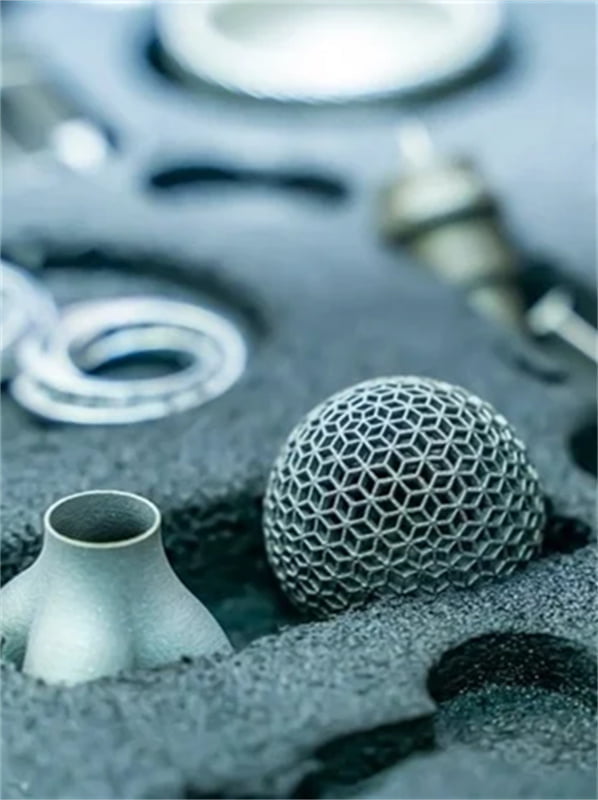
자주 묻는 질문
바인더 제트 3D 프린팅에 가장 적합한 입자 크기 범위는 어느 정도인가요?
약 30~50미크론은 층을 적절히 결합하는 데 필요한 높은 파우더 베드 밀도와 효율적인 액체 포화도를 촉진합니다. 너무 미세한 파우더는 성능을 저하시킵니다.
Ti 합금 가스 분무 시 오염의 원인은 무엇인가요?
공기 누출로 인한 산소 흡착은 파우더 순도를 저하시키므로 엄격한 공정 관리가 필요합니다. 용해로 분리제 및 용융 도가니는 고순도 소모품이 필요한 다른 오염원입니다.
Ti 기반 합금에서 높은 Mo 함량을 달성하기 어려운 이유는 무엇인가요?
진공 유도 용융 및 후속 재용융 단계에서 몰리브덴의 과도한 증발 손실은 25% 수준 이상에서 발생합니다. 완화 조치에는 용융 풀을 덮거나 저온 도가니 기술을 사용하는 것이 포함됩니다.
티타늄 파우더는 어떻게 보관해야 하나요?
불활성 커버 가스 또는 진공 상태에서 밀폐된 용기 안에 보관합니다. 변질을 유발하는 수분 흡수와 높은 산소 또는 질소 불순물을 배제하도록 취급 및 보관합니다.
티타늄 합금을 3D 프린팅할 때 흔히 발생하는 결함은 무엇인가요?
갇힌 기체 원자로 인한 다공성, 융합 결함 부족, 잔류 응력 균열, 밀폐된 부피 안에 갇힌 미융합 분말. 스캔 전략, 에너지 입력 등을 고려한 통합 파라미터 최적화가 필요합니다.
결론
요약하자면, 티타늄 몰리브덴 합금 분말 분말 야금 또는 적층 제조를 통해 항공우주, 에너지 및 기타 까다로운 산업 전반의 차세대 부품 생산에 필수적인 맞춤형 고온 특성 및 내식성을 제공합니다.
공유
중국 칭다오에 본사를 둔 선도적인 적층 제조 솔루션 제공업체인 MET3DP Technology Co. 당사는 산업용 3D 프린팅 장비와 고성능 금속 분말을 전문으로 합니다.
관련 기사
Met3DP 소개
최근 업데이트
제품

3D 프린팅 및 적층 제조용 금속 분말
문의 정보
- 칭다오시, 산둥성, 중국
- [email protected]
- [email protected]
- +86 19116340731






